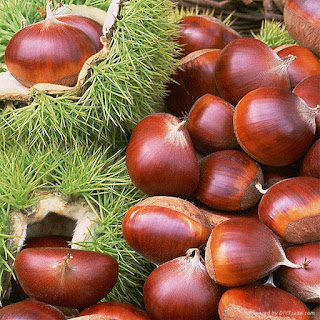1. Kacang Almond
The almond (Prunus dulcis, syn. Prunus amygdalus) is a species of tree native to the Middle East, the Indian subcontinent and North Africa. Almond is also the name of the edible and widely cultivated seed of this tree. Within the genus Prunus, it is classified with the peach in the subgenus Amygdalus, distinguished from the other subgenera by corrugations on the shell (endocarp) surrounding the seed.
2. Kacang Brazil
The Brazil nut (Bertholletia excelsa) is a South American tree in the family Lecythidaceae, and also the name of the tree's commercially harvested edible seeds.
3. Kacang mede
Cashew nuts are commonly used in Indian cuisine, whole for garnishing sweets or curries, or ground into a paste that forms a base of sauces for curries (e.g., korma), or some sweets (e.g., kaju barfi). It is also used in powdered form in the preparation of several Indian sweets and desserts. In Goan cuisine, both roasted and raw kernels are used whole for making curries and sweets. Cashew nuts are also used in Thai and Chinese cuisines, generally in whole form. In the Philippines, cashew is a known product of Antipolo, and is eaten with suman. Pampanga also has a sweet dessert called turrones de casuy, which is cashew marzipan wrapped in white wafers. In Indonesia, roasted and salted cashew nut is called kacang mete or kacang mede, while the cashew apple is called jambu monyet (translates in English to monkey rose apple).
4. Kacang Kastanye
The chestnut (Castanea) group is a genus of eight or nine species of deciduous trees and shrubs in the beech family Fagaceae, native to temperate regions of the Northern Hemisphere.
5. Kacang Kemiri
6. Kacang Pinto
7. Kacang Tanah
Peanuts is a syndicated daily and Sunday American comic strip written and illustrated by Charles M. Schulz, which ran from October 2, 1950, to February 13, 2000, continuing in reruns afterward. The comic strip is the most popular and influential in the history of comic strips, with 17,897 strips published in all, making it "arguably the longest story ever told by one human being". At its peak in the mid to late 1960s, Peanuts ran in over 2,600 newspapers, with a readership of around 355 million in 75 countries, and was translated into 21 languages. It helped to cement the four-panel gag strip as the standard in the United States, and together with its merchandise earned Schulz more than $1 billion.
8. Kacang Merah
9. Kacang Hitam
Black beans are a food that everyone can benefit from keeping in their kitchen cabinets. And it’s easy to benefit from black beans nutrition as they are an extremely affordable source of protein, filling fiber, disease fighting antioxidants, and numerous vitamins and minerals.
10. Kacang Navy
The navy bean is a variety of the common bean (Phaseolus vulgaris) native to the Americas, where it was domesticated. It is a small, dry white bean which is smaller than many other types of white beans, and has an oval, slightly flattened shape. It features in such dishes as baked beans, and even pies, as well as in various soups such as Senate bean soup. Unlike most canned vegetables, which lose much of their nutritive value in the canning process,[better source needed] navy beans maintain their nutritive value when canned.
11. Kacang Buncis
The kidney bean is a variety of the common bean (Phaseolus vulgaris). It is named for its visual resemblance in shape and colour to a kidney. Red kidney beans should not be confused with other red beans, such as adzuki beans
12. Kacang Tunggak
13. Kacang Kedelai
14. Kacang Hijau
15. Kacang Pistachio
16. Kacang Polong
17. Kacang Garbanzo
18. Kacang Lima
19. Kacang Fava
20. KacangMacadamia





















Tidak ada komentar:
Posting Komentar